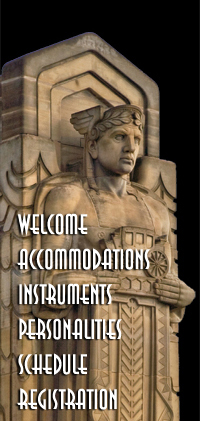First United
Methodist Church
Designed by architect J. Milton Dyer, the massive limestone exterior is noted for its grandeur and almost similar architectural massing concept to neighboring Trinity Episcopal Cathedral. However, the interior contrasts with that of the cathedral being highly ornamented and stenciled, and with stained-glass windows from the Mayer Company of Munich, Germany. The most prominent feature of the room and spanning the width of the chancel is the glorious Gothic organ façade built by William B. McAllister. The case pipes have stenciled accent bands and the four inset panels have full-sized reproductions of angels from the Linaiuoli Triptych by Fra Angelico.
This amazing façade has contained more than one instrument, but today houses the four-manual, 1943 Casavant organ (Opus 1715). This organ is perhaps the most controversial in Cleveland’s history. The church struggled with the limitations, restrictions, and taxes imposed on pipe organbuilders during World War II. The installation of the organ sparked a debate among numerous war board, government, and church officials attempting to resolve accusations of committing an unpatriotic act by violating rules on manufacturing and importing restricted goods from allied countries. Ultimately, the claims were dismissed, especially after the case was made that Casavant had harvested a substantial amount of metals out of the old Votteler-Hettche organ as source material.
The organ was dedicated by Canadian Charles Peaker, organist and teacher at the Toronto Conservatory of Music. Frequently used for recitals for just over a decade after completion, the annual concert series read like a “who’s who” of organists, including performers such as Robert Baker, E. Power Biggs, Claire Coci, Catharine Crozier, Marcel Dupré, Jeanne Demessieux, Richard Ellsasser, Virgil Fox, Fernando Germani, André Marchal, Marilyn Mason, Alexander McCurdy and Flora Greenwood, Flor Peeters, Bernard Piché, Richard Ross, and Alexander Schreiner. OHS member Joseph Dzeda recalls the Casavant organ as his “Road to Damascus.” As a young student entering college in Cleveland, Dzeda shifted his career goals following his encounter with the Casavant and today is a partner in the A. Thompson Allen Company—one of the nation’s most distinguished organ restoration specialists. Continuing in the spirit of inspiring future generations to seek out the historic pipe organ, our recitalist is Nathan Laube, rising star and young organ virtuoso from the Curtis Institute of Music.

|





